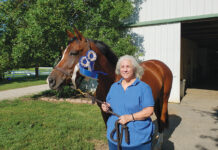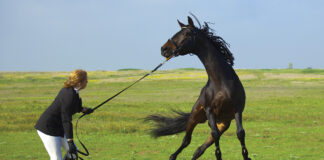Horses in the wild live together in bands as a means of defense against predators. This communal living arrangement necessitates that “rules” be established to govern social interactions between members of the herd in order to reduce the likelihood of serious aggressive conflicts within the group. These social interactions help the horses establish which horse is in charge, which one gets bossed around and all the ranks in between.

Within the Organization
So if size is what counts in determining who will dominate, what chance do we little humans have to gain the power position over animals five or ten times our size? Should we all just sell those saddles and take up badminton?
Fortunately, size isn’t the only thing that matters in the equine social order. We’ve all seen those small but spunky ponies calling the shots in their paddocks, or the old gelding that knows how to get along with any group of pasture mates. These exceptions to the rule of size tell us that factors such as age, gender, prior experience living in groups and temperament also play some role in establishing an animal’s rank within the group.
The Young Filly’s Rank
When it comes to age and dominance status, there’s nobody lowlier than a newborn foal, especially a filly. Pull this youngster away from mom, and she becomes fair game for any horse’s social conquest. But leave her next to mom and the foal will share her mother’s dominance status while they move about together, interacting with the others.
Besides inheriting the genes from the dam that will allow the foal to someday grow large enough to physically insist on a particular rank, the foal is also learning from her mother how to behave as a dominant horse with respect to other herd members.
This is why the argument for early handling of foals makes such good practical sense. We’re teaching the foal that it must be submissive to us while it is still too small and weak to resist us. Sometimes a physical reprimand is required to reinforce our dominance, but it must be delivered the way it would be from another horse – sharp and quick. A drawn-out, physical reprimand can result in fear or panic in the horse.
Fillies tend to rank lowest within their group. Therefore, the sex of the horse does have some effect on status, although this can vary widely between herds. Normally, we would expect to see a stallion at the very top of the pecking order, which, as related to the hormone testosterone, accounts in large part for the aggressive behavioral tendencies we see in many stallions. Following stallions are mature mares, mature geldings (if present), yearling colts, yearling fillies, weanling colts and finally, weanling fillies. It is not unusual to see mares and geldings mixed throughout the ranks, and so it is best to consider the dominance status of these two groups as similar, with much greater variation between individual horses rather than between the two groups.
Disposition Matters
Aggressive and persistent horses will eventually dominate over larger but more placid-tempered horses through the triumph of tenacity. This is often what we see going wrong in horse/handler relationships where the equine is bold and willful and the human a bit more gentle or passive. Sometimes the sincere but unfortunately misguided person believes that the horse/human relationship is an equal partnership, not realizing one partner has to assume the dominant role according to the guidelines horses themselves live by.
A little time spent with a reputable trainer working on developing gentle but absolute assertiveness in dealing with a dominant horse can reap long-term dividends in terms of effecting compliant and manageable behavior.
Learning to recognize a disagreement as a dominance problem allows you to resolve it in a way that your horse will understand, putting you back on the road to a truly harmonious relationship.
Further Reading
Training without Force
How to Speak Horse
Taming the Aggressive Alpha Mare







This was a very interesting article! It gave me an idea on what to expect if I ever get more horses.